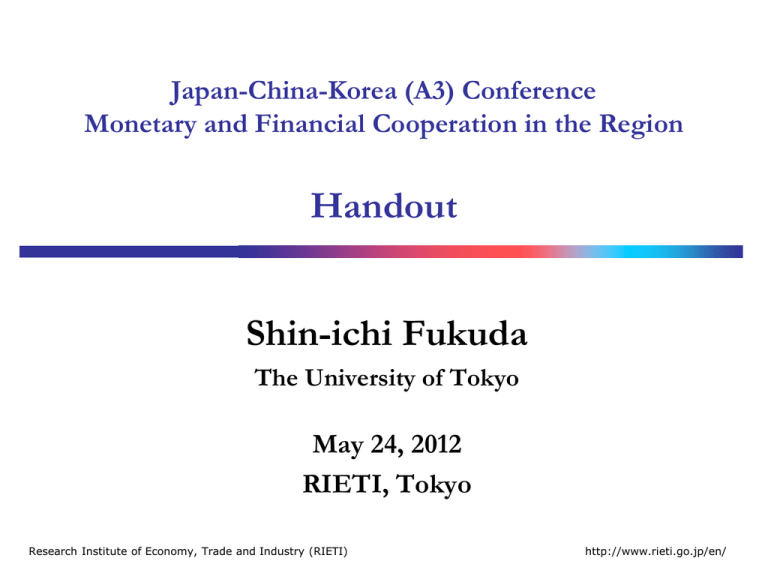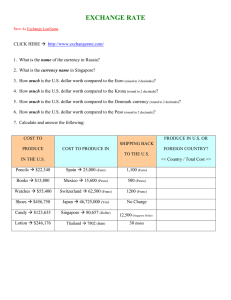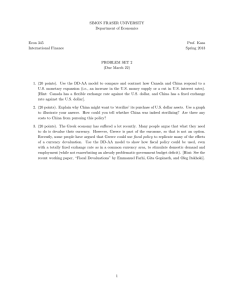Handout Shin-ichi Fukuda Japan-China-Korea (A3) Conference
advertisement

Japan-China-Korea (A3) Conference Monetary and Financial Cooperation in the Region Handout Shin-ichi Fukuda The University of Tokyo May 24, 2012 RIETI, Tokyo Research Institute of Economy, Trade and Industry (RIETI) http://www.rieti.go.jp/en/ Comments on “Global Needs for ACU-Denominated Reserve Assets” by G. Choi and Y. Rhee Shin-ichi Fukuda (University of Tokyo) 2 Two Issues • International capital flows in Asia (capital flows with long-term maturity) ⇒ Double mismatch ⇒ ABMI, ACU • International liquidity in Asia (capital flows with very short-term maturity) ⇒ Settlement risk in US dollar ⇒ CMIM 3 I. International capital flows in Asia East Asia Household High savings Local firms Local Financial institutions Long-term Local currency Long-term Dollar-denominated Low return USA Europe Financial markets Short-term Dollar denominated High return Double mismatch! 4 Ratios of External Debt Outstanding to GDP before the Crisis Korea Indonesia Malaysia Philippines Singapore Thailand Hong Kong China Taiwan 1994 14.32 60.96 40.4 62.42 10.79 33.31 18.38 18.38 10.87 1995 23.8 61.54 39.31 53.21 9.84 33.78 16.6 16.6 10.4 1996 28.4 56.74 40.06 49.75 10.74 50.05 15.44 15.44 10.07 5 Ratios of Short-term Debt Outstanding to Foreign Reserves before the Crisis Korea Indonesia Malaysia Philippines Singapore Thailand Hong Kong China Taiwan 1994 54.06 160.36 24.34 95 1.75 99.48 16.49 33.04 21.76 1995 171.45 189.42 30.6 82.85 1.78 114.21 14.16 29.62 21.64 1996 203.23 176.59 40.98 79.45 2.6 99.69 22.35 23.74 21.31 6 Short-term Loans before and after Crisis millions of U 80000 60000 40000 20000 0 93.12 94.6 94.12 95.6 95.12 96.6 96.12 97.6 97.12 98.6 year Thailand Indonesia Korea South 7 Medium-term Loans before and after Crisis millions of U 10000 8000 6000 4000 2000 0 93.12 94.6 94.12 95.6 95.12 96.6 96.12 97.6 97.12 98.6 year Thailand Indonesia Korea South 8 Asian Bond Market and ACU East Asia Household High savings Local firms Long-term Higher return ACU or US dollar Local Financial institutions Long-term Local currency No mismatch! Asian Bond Market (secured by governments) Local-term ACU denominated(?) Smaller return secure Foreign Exchange Rate Reserves 9 II. International liquidity in Asia • The role of US dollar as international liquidity is dominant in East Asia. • More than 70% of the foreign exchange turnovers in the Tokyo Market have been those from the US dollar to either Japanese yen or to Euro. • The US dollar is also dominant in invoice currency ratios in Asian's exports and imports. 10 Currency Shares of Foreign Exchange Turnover in the Tokyo Market Apr-04 Yen ↔ US Dollar 60.6 Euro ↔ US Dollar 11.7 Euro ↔ Yen 6.9 Others 20.8 Apr-07 58.2 10.8 5.9 25.1 Unit: % Apr-10 62.3 9.5 8.6 19.7 11 Invoice Currency Ratios (%) in Japan's Exports Exports to USA 2006 2008 2009 2011 July-Dec. Jan.-June July-Dec. Jan.-June US dollar Yen Euro 89.1 10.8 0.1 87.6 12.2 0.2 86.8 13.0 0.1 83.1 16.8 0.1 Exports to East Asia 2006 2008 2009 2011 July-Dec. Jan.-June July-Dec. Jan.-June US dollar Yen Euro 49.5 48.8 n.a. 48.3 50.0 n.a. 50.7 47.5 n.a. 48.6 49.3 0.2 12 Invoice Currency Ratios (%) in Japan's Imports Imports from USA 2006 2008 2009 2011 July-Dec. Jan.-June July-Dec. Jan.-June US dollar Yen Euro 75.6 23.6 0.7 79.7 19.3 0.6 79.2 19.7 0.4 77.5 21.9 0.4 Imports from East Asia 2006 2008 2009 2011 July-Dec. Jan.-June July-Dec. Jan.-June US dollar Yen Euro 72.4 26.0 0.3 71.7 26.9 0.3 70.5 27.9 0.4 71.6 26.8 0.3 13 US dollar liquidity in Asia • Foreign exchange markets are open for 24 hours a day. • But transaction volume is limited during the Asian time zones. • Transaction volume is thickest in London markets. • Dollar liquidity is provided by FRB. 14 15 Policy prescriptions • Use of ACU as liquidity. But less realistic in short-run. • CLS (Continuous Linked Settlement): the largest multi-currency cash settlement system, eliminating settlement risk for over half of the worlds FX payment instructions. • FRB dollar swap • CMIM 16 Central bank liquidity swaps • The Federal Reserve established temporary reciprocal currency arrangements (central bank liquidity swap lines) with a number of foreign central banks. • Because of the global nature of bank funding markets, the Federal Reserve coordinates with other central banks to provide liquidity. 17 17 17 18 18 18 CMI Multilateralization vs Central bank liquidity swaps • CMI multilateralization (March 2010): - Total US$ 120.0 billion - Japan : US$ 19.2 billion - Korea : US$ 19.2 billion - China : US$ 19.2.0 billion • Central bank liquidity swaps: - USA ⇒ Japan : unlimited - USA ⇒ Korea : US$ 30.0 billion - Total supplied : US$554 billions But only to Japan, Korean, and Singapore in Asia 19 19 19 Problems of CMIM • Limit on borrowings tied with the capital contribution • Limited autonomous lending (20% of potential lending) with IMF conditionality • We need unlimited autonomous liquidity provisions for unexpected settlement risk! • Even US dollar shortage in a few seconds may cause a serious settlement risk. 20 Local currency Bank A unlimited Bank B Bank C Local Central bank (Lender of last resort) Bank Z 21 International currency Bank A Central bank or Local government Bank B Central bank or Local government Bank C Central bank or Local government FRB CMIM Bank Z Central bank or Local government Foreign Exchange Rate Reserve 22 Further development of CMIM • • Foreign Exchange Reserves in Japan and China Japan: US$1,043 billions in June 2009 China: US$2,427 billions in March 2010 The sum of them (US$3.5 trillions) is far above the total supply of FRB’s central bank liquidity swaps in the world (US$554 billions). • Asia has enough room for further extension of CMI multilateralization! ⇒ Further development of regional policy coordination is possible. 23 23 23







